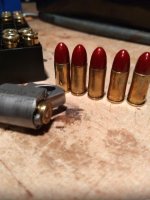skyking897
Member
- Joined
- May 17, 2019
- Messages
- 16
- Reaction score
- 7
I recently picked up a S&W 39-2 (my first 9mm). I had been shooting factory ammo, different brands before I decided to start reloading for it too. Reloading for my .357 seems so much easier, less confusing. This is when I learned about the "Glock Bulge" and 9mm brass is tapered. So I picked up some used brass at the range a couple of weeks ago and tried dropping some in my barrel and it won't go in as far as the factory rounds. I'm guessing this is the Glock Bulge? Anyway, I picked up a Lee Bulge Buster along with a set of carbide dies. While prepping the brass I noticed the rounds I fired thru the 39 take no effort at all to go thru the bulge buster but a lot of the range brass I picked up takes a huge amount of effort to press thru it and appears to be removing material from the rim too. It measures the same as the base of the brass now. Before I go too far here, I'm wondering if this is right or I'm doing something wrong? And is it supposed to be that hard to push a round thru the bulge buster?


